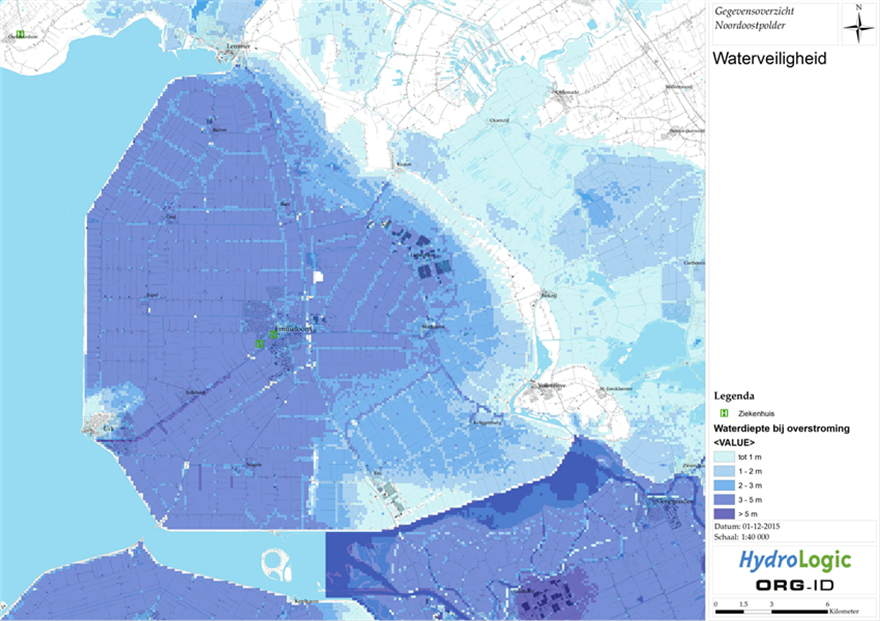Climate stress test light, Municipality of Noordoostpolder
In the autumn of 2015, the municipality of Noordoostpolder commissioned a climate stress test light with the support of the Ministry of Infrastructure and the Environment. No full stress test was conducted. The aim of the “stress test light” is to gain greater insight into the impact of climate change on the living environment and the interconnection between the various climate issues. This has been mapped out. The maps focus on the four themes of the climate impact atlas.
Results
The stress test showed that:
- At the regional level, the Noordoostpolder is particularly vulnerable to coastal flooding, pluvial flooding as a result of flooding from the surface water system, and drought in relation to ground subsidence. These subjects are all addressed in regional processes.
- The Noordoostpolder accommodates vital, vulnerable infrastructure and buildings. It is not clear, however, whether the picture presented here is complete.
- At the level of urban areas, bottlenecks could appear in the future due to pluvial flooding (water in the street), and heat stress due to climate change and an increasing volume of paving. This pertains not only to public spaces, but also to private property where, increasingly, paving seems to be being laid. The impact this may have is not known in any detail; this requires further knowledge to be developed.

The climate change studio has shown that the proposed restructuring plans for the Centrumschil Emmeloord is seen as a “golden opportunity” to tackle the increasing challenge of climate change in the urban area. For example, the Centrumschil (neighbourhoods immediately surrounding Emmeloord’s city centre) is characterised by slight differences in elevation. This fact can be used to allow rainwater to flow at ground level to green spaces or to bodies of surface water. The climate change studio has established that the climate change tasking and the ensuing ambitions and spatial design interventions for Emmeloord can easily be merged and combined with the vision of the “city’s DNA”. Here considerable energy and dynamics are embedded in the approach to the challenges faced in the area. The process chosen to meet these challenges with the participation of residents fits in well with concept of climate-resilient actions. An early approach is needed to gain broad social support for this effort. At the municipal level, there is wide interest and involvement in climate change issues, beyond the staff directly involved with the substantive job of water management and drainage. From the perspectives of spatial planning/urban development and the management of green areas and roads, in particular, staff see opportunities for improving the “quality of the living environment” and linkage with various spatial taskings.
Recommendations
Climate adaptation is a matter not only for the government. Its impact on social life concerns all residents and businesses. And measures will not be implemented by the government alone; residents and the private sector, too, will do their part. To achieve this, an ambition level – “dot on the horizon” – and an implementation strategy will need to be developed together with the stakeholders.
Prospective next steps after this “stress test light” are:
- Within the climate change studio, flood risk management was only discussed in passing, because here a home-grown process is underway, and this issue plays out on the regional 19 level, whereas the climate change studio is focused on the local level. With a view the area’s vulnerability to flooding, it is advisable to map out vital and vulnerable infrastructure and buildings, develop an evacuation strategy, map out evacuation routes and locations, and determine a communication strategy (risk communication).
- Further exploration of pluvial flooding and heat stress. Gain a (better) picture of the effects of extreme rainfall and heat stress on Emmeloord and the surrounding villages. Based on these outcomes, determine whether adaptation and/or supplementation of the deployed implementation strategy via the area tasks is necessary for Emmeloord or not. Detailed images can provide reason enough to reconsider and, if necessary, adapt past design ideas. It can also be reason enough to take additional measures outside the frameworks of the area taskings.
- Climate adaptation is not only a challenge, it is also an opportunity in interconnection with the quality of life and other matters. The climate tasking requires the government, businesses and residents to become aware of the fact that the increase in the amount of paved surface area on public and private lands can raise the risk of pluvial flooding and higher temperatures (“heat island effect”) in people’s living environment. Collective processes at the local level must be developed to create a green-blue (vegetation/water bodies) living environment.
- Linkage can be achieved by including and integrating these effects of climate change in the elaboration and implementation of climate-adaptive measures for restructuring, large-scale maintenance, new construction, and strengthening the current DNA of Noordoostpolder. Include their elaboration and implementation into the solutions developed in the participation process. To this end, it is important in a future follow-up to continue to involve the current parties in the presented climate change studio so that, together, they can capitalise on the opportunities identified. Climate-proofing the area fits in well with an integral area approach by linking climate-adaptive measures to, e.g., future and current restructuring tasks. This requires a broader approach and involvement, and it is not limited to the municipal government. External parties, too, such as the provincial government, the district water board, the housing corporation and the water company are all invited introduce proposals and plans into this process. In the end, the proposed measures must also be shared with the residents.
- At the regional level, an exchange of knowledge can be accomplished by actions such as sharing the results from an analysis to be conducted for the Centrumschil Emmeloord with the other municipalities in the province of Flevoland.
Contact person
Jehannes de Leeuw
Gemeente Noordoostpolder
+31(0)527-63 32 59
j.deleeuw@noordoostpolder.nl
